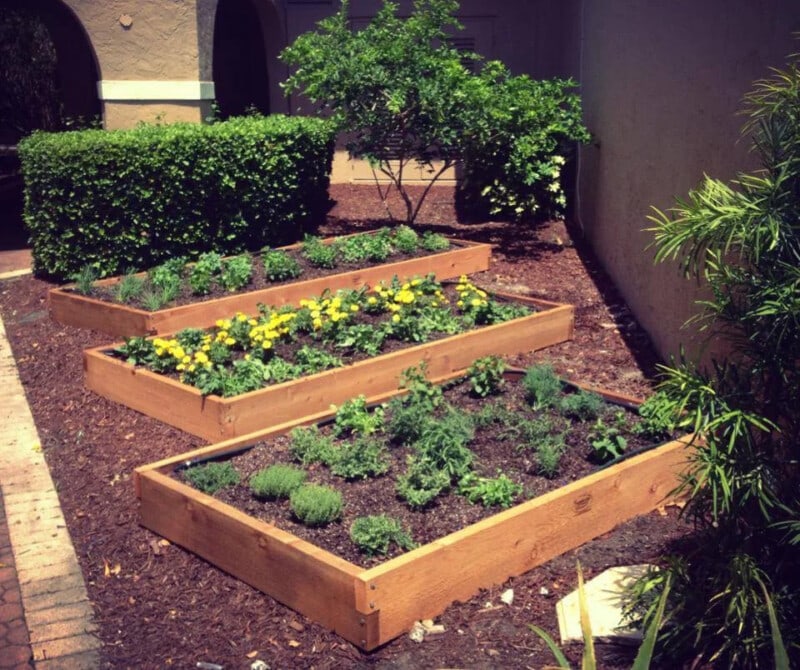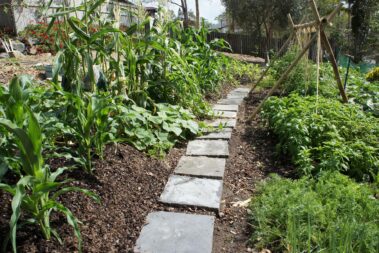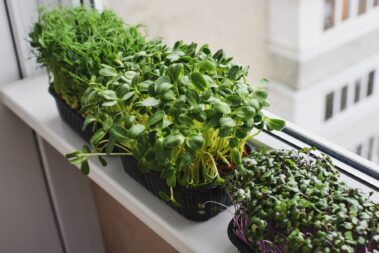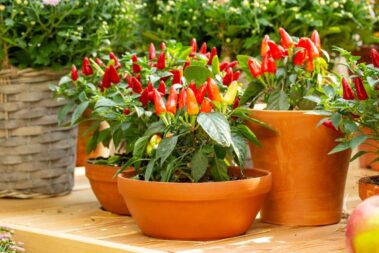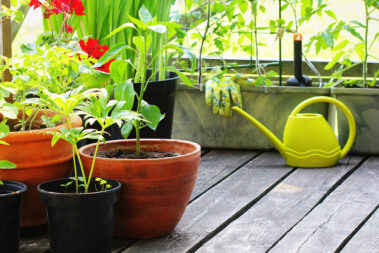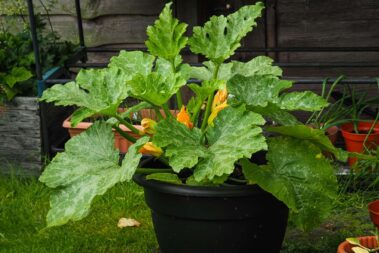One of the simplest ways to elevate your cooking is to use fresh herbs in place of dried herbs and spices. But buying fresh herbs at the grocery store is not the most economical.
Luckily, most herbs are super simple to grow at home. They don’t require much space or tending. And many are just as easy to grow indoors as out.
In this article, we’ll look at the easiest herbs to grow at home. Then we’ll walk you through the best ways to create an outdoor herb garden and show you how to grow herbs indoors, as well. Lastly, we’ll give you some of our favorite clean, green recipes so you can put your homegrown herbs to use.
Table of Contents
Easy Herbs to Grow
Herbaceous plants technically include any plants that do not form permanent woody stems. These plants die back completely over the winter and feature flexible branches with leafy growth.
In the culinary world, we add a second qualifier to this definition. And that is that herbs have to be edible and full of flavor.
While this second piece is what makes cooking with herbs so great, it’s the first part that makes them easy to grow. Herbs, by nature, don’t get too large, have less stringent soil and nutrient requirements compared to other plants, and are widely available.
Herbs can be grown easily from seed. But they take even less time and effort to grow when purchased as a seedling from your local garden store.
Despite how easy herbs are to grow in general, there are some herbs that are better suited for beginner gardeners. Here are ten easy-to-grow herbs you should consider adding to your new herb garden.
Basil
Basil is a popular herb used widely in savory and sweet recipes. It’s especially popular in Italian cooking, as a garnish, and in cocktails. Basil comes in red and green varieties, each with a different flavor.
This productive plant grows quickly and is generally ready for the first harvest within a month of seeding. It can be harvested throughout the season and is suitable for indoor and outdoor herb gardens.
Chives
Chives are a type of non-bulb-forming allium that produces edible, hollow, leaves. These plants rapidly spread in the garden and are harvestable all season long. There are many varieties of chives that range in flavor from zesty and sweet to deeply garlicky and spicy.
Chives can be grown indoors, but make an especially great addition to the outdoor garden because they are one of the first greens to pop up in the spring.
Cilantro
Cilantro is a must if you like cooking Mexican cuisine, but it has a range of applications beyond this. The greens provide a zesty, citrusy, slightly astringent flavor to dishes. Meanwhile, the seeds can be dried and ground to create coriander spice.
This lacey, leafy plant is an easy keeper that grows well indoors and out.
Dill
Dill isn’t as tolerant of imperfect conditions as other herbs, but it is worth growing. It’s especially nice to have on hand if you like to pickle your own vegetables. Dill is also great for creating homemade dips and dressings.
Dill needs a lot of sunlight for bushy growth and is best suited for outdoor gardens or indoor pots under a grow light.
Lemongrass
Lemongrass is a tropical grass that is grown as an herb for its lemony flavor. It’s common in Eastern cuisine but has far-ranging applications. The leaves can be dried and used in teas or pulverized to flavor cocktails.
This tropical plant is a great choice for indoor herb gardens since it does not tolerate cold very well.
Mint
There may be no easier herb to grow than mint. This productive plant grows well in a variety of environments and will take over your garden if you let it.
Mint comes in many types to meet all culinary needs. Peppermint and chocolate mint are great for desserts and sweet drinks, spearmint is great for savory dishes, and lemon balm makes a wonderful tea. All varieties are highly aromatic, and the oils from the leaves are often used for aromatherapy.
Oregano
You can’t make any good Italian dish without oregano. This mild yet tasty herb is also used frequently in Mexican and American cooking. The leaves can even be infused into honey for an incredible sweet and savory treat.
Oregano is easy to grow. It prefers soil that dries between waterings and benefits from frequent harvesting.
Parsley
Parsley comes in two varieties: flat-leaf (Italian parsley) or curly-leaf. The former is very flavorful and incorporated into a variety of dishes from pasta to salads. The latter is used more often as a garnish.
This lanky leafy green is easy to grow indoors and out but will produce better with plenty of sunshine.
Sage
Sage is a perennial plant that grows and produces well even under dry conditions. The fragrant leaves are used to flavor savory dishes and make a great addition to roasted vegetables. Sage also has multiple spiritual applications and is often dried and burned to cleanse the home and spirit.
Sage needs plenty of sunlight but can be grown indoors with a grow light.
Thyme
Thyme is used widely as a flavoring for savory dishes, including stews and roasted vegetables. It’s packed with antioxidants and many health-supporting phytochemicals. Eating thyme can even help fight bacterial and fungal infections.
Thyme is easy to grow inside or out but does not do well in soggy soil.
How to Create an Outdoor Herb Garden
Outdoor herb gardens have the benefit of being larger and therefore more productive than indoor options. Not only can you grow enough herbs for your kitchen, but you’ll likely have herbs to share with neighbors. Of course, keeping the garden outside also makes it easier to keep dirt and bugs out of the house.
Equally important, gardening outdoors gets you out into the sunlight and fresh air. The act of building a garden provides exercise while maintaining it can quickly become a therapeutic activity.
If you have the space and means, an outdoor herb garden is absolutely worth it.
Options for Outdoor Herb Gardens
Herbs require a lot of sunshine and generally need to be placed on a south-facing plot. These plants grow best in nutrient-rich, well-maintained soil.
There are tons of different options for building your new herb garden that will meet these requirements. Below, we’ll look at the three main types of gardens that work especially well for growing herbs.
In-Ground
Pros:
- No building required
- Cheap to create
- Utilize existing resources
Cons:
- Must till the soil
- Harder to amend the soil
- Can encounter drainage problems
- Harder to keep weeds out
- Must work at soil level
In-ground gardens are the cheapest option to create. They don’t require buying any special materials or building anything. In many cases, you don’t even need to buy soil.
Of course, this doesn’t mean in-ground gardens are completely labor-free. In most cases, the soil needs to be tilled to decompact it and amended using compost to increase the nutrient content. Once made, in-ground gardens are also harder to maintain because it’s easier for grass and weeds to make their way in.
For older gardeners and those with mobility issues, in-ground gardens may not be a great choice. Weeding, planting, and harvesting will require you to get down to the soil level. This can be hard on the knees and back.
If you do decide to go with an in-ground garden, here are a few things you’ll need to get started:
- Compost – Whether you’re removing lawn or working with an already cleared plot, you’ll still need to amend the soil for best results. Mixing in quality organic compost adds nutrients and important microbes to existing soil without the risk of run-off that comes with using fertilizers.
- Garden Edging – Edging your garden is important to help keep grass and creeping weeds from overtaking the freshly turned soil. Edging is available in many styles from utilitarian coil edging to decorative options like mini-fence edging that can help add character to your new plot.
- Mulch – Mulching an in-ground garden can help keep weeds from germinating. Choose an all-natural product that will be easy to remove and reapply each season. We recommend cedar mulch because it also helps keep pests at bay, but leaves, straw, and other organic material you might have lying around will work as well.
Raised Beds
Pros:
- Fewer problems with weeds
- Easier to tend
- Easier to control drainage and soil quality
Cons:
- Must be built or purchased
- Space is limited
- Can be expensive
- Usually requires purchasing soil
Raised beds have a lot of advantages over traditional gardens. Raising the soil off the ground helps keep grass and weeds from creeping into the beds. It also reduces how many weed seeds land on the soil.
Depending on the height of the bed, they can also make the garden easier to maintain. Tall raised beds don’t require kneeling to work in and lower raised beds are still easier on the back than in-ground gardens.
But creating a raised bed takes time and can cost a lot, depending on the materials you use. Most beds are made from wood and require you to build them. Once built, the garden has to be filled with special soil meant for raised gardens.
These gardens typically require more water than in-ground gardens because much of it runs out the bottom. But, for most herbs, this fast drainage is actually a good thing. You’ll have to water more often, but the herbs will grow better if their roots never get soggy.
There are countless ways to create raised herb garden beds. And if you get creative enough, you can often do so without spending a ton of money. Still, there are some materials that are better suited for creating raised beds than others.
Here are some of the best options for materials to build a raised bed with:
- Wood – Boards are easy to work with and can be used to create beds in various sizes and shapes. But wood is not cheap and it doesn’t last long, especially if it’s not maintained.
- Corrugated Steel – Corrugated steel is much longer-lasting than wood, but is harder for the average homeowner to cut and work with.
- Composite Lumber – This material isn’t the most earth friendly or affordable, but it lasts longer than wood while being just as easy to work with. If you have some left over from a recent deck or home project, using it for your garden is a great option.
- Cinder Blocks – Cinder blocks are easy to work with, easy to secure using rebar, and provide a cheap option for building raised beds. They look very utilitarian but will last a long time.
- Straw Bales – If you have some extra straw bales laying around, you can quickly and easily create a raised bed. This is a bulky option that yields far less soil space, but straw provides extra insulation that can help extend your growing season.
If the idea of building your own raised bed seems daunting, but you want an herb garden that’s easy to maintain, a raised bed kit is a great option.
These pre-cut kits come with all the pieces you’ll need to create a raised bed and only require a drill to put together. For corrugated steel, we like this kit by Foyuee. And for wood, it doesn’t get any better than this standing-height herb garden kit.
Pots
Pros:
- Easy to get
- Portable
- Many options available
- Can be done affordably
- Fewer weed problems
Cons:
- Requires specialty soil
- Limited space
- Requires frequent watering
- Can restrict production
Potted herb gardens provide many of the benefits of a raised garden with fewer drawbacks.
Pots raise your plants off the ground to make them easier to tend while greatly reducing weed problems. They’re also portable, allowing you to start the garden inside and move it out, or move it to the optimal location for sun and shelter as the seasons change.
But, like raised beds, pots require specialty soil that adds to the cost. The pots themselves can be expensive or cheap depending on what you choose.
Due to the limited space inside pots, even large ones, frequent watering is required. And many herbs will experience production slow-downs as they get larger due to restricted root growth.
But for those looking for an easy, non-permanent herb garden solution, pots are the way to go.
In terms of what kind of pots to use, you have many options, each with its own pros and cons.
- Terracotta – Terracotta pots are sturdy and provide natural airflow to the soil which helps roots stay healthier. But they’re also prone to cracking and cause soil to dry out much more quickly than other options. These are a good choice if you have lots of time to tend to your garden, have an irrigation system in place, or need something that will not blow over.
- Plastic – Plastic pots are not as earth-friendly and are prone to getting blown over. But they are fairly inexpensive and easy to move around. Plastic is a good choice for gardeners who are putting together a potted herb garden on a budget.
- Fiberstone – These concrete-look-alike containers are made with fiberglass and crushed concrete. They have the classic look of concrete pots but are lightweight and can withstand freezing temperatures. They are a good option for gardeners who want something that looks substantial but is easy to move around.
- Glazed – Glazed containers are heavy like terracotta but come in a variety of finishes. On the downside, they still dry out quicker than plastic and are prone to chipping and cracking. These are good options for gardeners who want a semi-permanent potted garden that looks gorgeous.
- Wood – Wood pots and barrels are a natural pot solution that has a classic look. But they don’t last forever and can dry out more quickly than other options.
Whatever style of pot you choose, the most important thing is that it provides plenty of drainage. Most herbs require well-drained soil and will suffer if their roots stay soggy. Look for multiple drainage holes on the bottom or at least one large hole in the center.
To help retain moisture without causing root rot, opt for potting soil to fill the pots with. This specialty soil contains substrates that aerate and improve drainage while also holding onto moisture and nutrients.
How to Create an Indoor Herb Garden
While outdoor herb gardens are optimal, indoor gardens have their own advantages. For one, your herbs will always be right there when you need them. And plants grown indoors are much less susceptible to disease and don’t need weeding.
On the downside, it can be tough to provide enough light for indoor herbs. It can also be a messy process and take up room in your kitchen or living room. If you need extra light, growing herbs indoors will also use up energy.
While this process may not be as therapeutic or get you outdoors for fresh air and exercise, it is the only choice some people have. If you don’t have a yard or simply lack the space for an outdoor garden, growing herbs inside is the next best thing.
Step-by-Step Guide to Creating an Indoor Herb Garden
Creating a productive indoor herb garden requires a few things. Our helpful step-by-step guide will walk you through the process of putting together a garden that will provide fresh, homegrown herbs all year long.
1. Choose the right plants
With enough light and attention, you can grow just about any herb inside. But there are certain species of herbs that fare better indoors than others. If you are new to indoor gardening, we recommend choosing your preferred variety of oregano, thyme, rosemary, basil, parsley, cilantro, or chives. Mint is also another good candidate, especially for novice gardeners, as it tends to grow rapidly and is difficult to kill.
You can start your indoor herb garden with seeds, seedlings from your local nursery, or with cuttings from your outdoor garden or produce drawer. If you go the cuttings route, just make sure you clip a branch with a node and allow roots to develop in water before transplanting into pots.
2. Choose the right pots
Finding adorable pots and containers to match the aesthetic of your kitchen is one of the most enjoyable parts about creating your indoor herb garden. Any color, material, and shape will do so long as it has good drainage and is big enough to support a mature plant. We recommend pots with a minimum diameter of four inches to start. You’ll also want to make sure the pots come with a tray or dish to protect your counter or window sill from water damage.
Once you have your pots, fill them with organic potting soil. Regular garden soil or dirt from outside will dry out too fast and doesn’t contain enough nutrients for potted plants.
3. Find the best spot
The trick to growing thick, beautiful herbs indoors is to find a bright, sunny location. A south-facing window is the best option, but large, bright west or east windows will work as well. Make sure to rotate your plants frequently as they mature to assure thick growth on all sides.
If you don’t have a sunny window available, you aren’t out of luck. We’ll look at some creative solutions to overcoming a lack of light in the next section.
4. Water, feed, repeat
Herbs enjoy moist soil, but won’t fare well if they get too soggy. Good drainage will help avoid that problem while consistent watering will keep your pots from drying out. Check your soil daily by pressing on the dirt near the base of the plant. As soon as it feels dry to the touch, place your herbs in the sink and give them a good soaking. Allow them to drain thoroughly before placing them back on their tray.
Herbs tend to be easy keepers and don’t rip through nutrients as fast as vegetables do. But any plant grown in a container long enough will eventually need to be fertilized. An all-purpose liquid organic fertilizer added about once a month should suffice.
5. Harvest and enjoy
Once your plant has numerous leaves and more than a few branches, begin harvesting by pinching off sprigs just above a mature leaf pair. Harvesting frequently from all sides of the plant will encourage bushy, symmetrical growth. This is true of most thicker-branched herbs like basil, oregano, and rosemary.
For thin-branched herbs like cilantro, harvest sprigs by taking the top third of the branch. This will allow plenty of regrowth in the lower portion of the plant. For chives, cut individual leaves about an inch above the soil.
Creative Ways to Grow Herbs Indoors (Sunny Window Optional)
Have a north-facing kitchen window? Or lack the space on your window sill to keep pots? You can still grow a productive herb garden, so long as you’re willing to get a little creative. Here are some of our favorite solutions to a less-than-ideal indoor garden space.
Grow Lamps and Mini Lights
The number one issue most people will run into when growing herbs indoors is a lack of light. Even some south-facing windows fail to allow enough light in the winter months or get blocked by foliage in the summer. Mini grow lights that attach to the window sill or to the pots themselves, like these from Juhefa, are perfect for supplementing light in these situations.
If you don’t have space to spare next to a window, a floor or desk grow lamp might be a better solution. These lights are larger and brighter to supply all the light your herbs will need. These types of lights are self-supporting and much more aesthetically pleasing than your typical grow light.

Vertical Planters
If your problem is more one of space than light, a vertical planter may be a good solution. These types of containers have a small footprint and multiple openings up the sides to allow plants to grow one on top of the other. They have a similar structure and look as vertical wall planters but without the need to sacrifice wall space or break out the drill.
Like your typical potted herb, these planters do need to be rotated frequently to make sure the plants on all sides get enough light. Many options, like this vertical planter from Mr. Stacky, allow you to change the height and number of cells depending on how many herbs you’re growing.
Wall Mounted Vertical Gardens
If you do have the wall space, a mounted vertical garden is an effective solution and a beautiful addition to any space. These systems use low-profile angled pockets that allow the plants plenty of room to grow without taking up a lot of space.
Best of all, there’s an endless number of designs available from this simple waterproof cloth hanger by Angtuo, to these smart self-watering hanging pots from Bouqlife.
Hanging Pots
Another great way to create an indoor herb garden when you’re short on space is to use a hanging pot system. Not only will these free up space on your counter and window sill, but many of them look gorgeous and add a lot of character to the room.
Some hanging pot systems work with an overhead bar while others are attached to the window with suction cups or to the wall with individual hooks. Whichever one you choose, drainage is likely to be an issue. Instead of planting your herbs directly in the pots provided, we recommend finding a plastic insert with drainage holes that will fit nicely into the containers. This way you can remove the herbs to water them and avoid the soil becoming too waterlogged.

Light and Shelf Systems
If you’re serious about growing prolific herbs all year long, a sophisticated shelf and grow light system might be the best option for you. These systems tend to be highly customizable and come in a variety of sizes, colors, and designs.
You can even build your own shelf system using thin strip grow lights like these from Mosthink. Simply attach the lights to the underside of an old set of shelves or custom unit and run the chords out the back. Your plants will get all the light they need and you’ll be able to put them anywhere you have space. You can even utilize the extra space on the shelves for cookbooks and other kitchen essentials.

Put Your Herbs to Use with These Great Recipes
Once your herb garden starts producing, you’ll need some inspiration to put your harvest to use. Here are a few of our favorite herb-heavy clean, green recipes.
NOTE: To replace dried herbs with fresh ones, simply use 3x the amount listed in the recipe.
- Rustic Rosemary Herb Crackers – These deliciously herby crackers call for rosemary, sage, and thyme.
- Fresh Vegan Potato Gnocchi – Top this amazing gnocchi with fresh basil, oregano, and/or thyme for a simple, elevated meal.
- Homemade Vegetable Broth – This broth is made with a plethora of delicious veggies and a handful of rosemary, dill, parsley, and other easy-to-grow herbs.
- Vegan Pot Pie with Puff Pastry – Fresh thyme and sage go into this classic comfort dish while savory herbs of your choice garnish the top.
- Cucumber Gazpacho – This awesome recipe calls for a full cup of fresh herbs and can be made using mint, basil, or cilantro.
- How to Pick the Perfect Watermelon For a Sweet Summer Treat - April 10, 2024
- Future Kind’s Foundations: A Multivitamin Made for Vegans - December 5, 2023
- Does Nutritional Yeast Go Bad? - November 28, 2023

